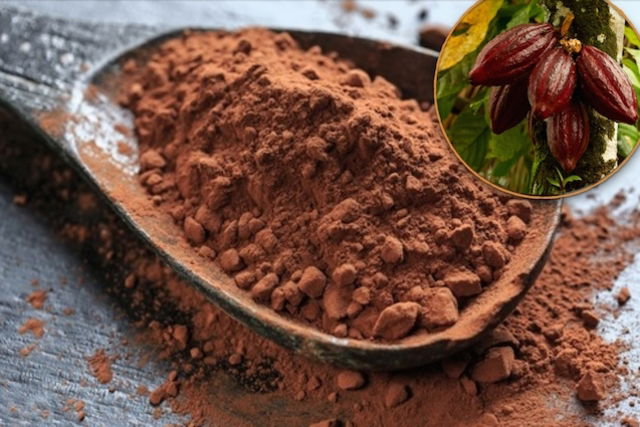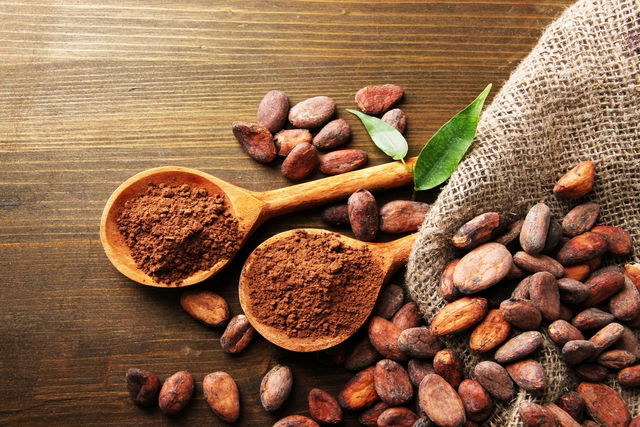Regularly consuming cacao can offer many health benefits, like improving your mood, optimizing blood circulation, regulating blood sugar levels, and protecting heart health. These are possible because cacao contains natural anti-inflammatory and antioxidant properties.
Cacao is made from the seeds of the cacao plant, and is the main ingredient in chocolate. It is rich in flavonoids, mainly epichatechins and catechins, which are compounds with antioxidant action.
To obtain all the benefits cacao has to offer, you should consume 2 teaspoons of cacao per day, or 40 g of dark chocolate (which is equivalent to about 3 small squares)

Health benefits
Consuming cacao on a regularly basis can provide many health benefits, including:
1. Improving mood
Cacao is rich in theobromine, caffeine, phenylethylamine and tyramine (the precursor to tryptophan that facilitates serotonin production). These substances can positively influence the production of serotonin, which is directly related to mood, heart beats, sleep and appetite. Cacao can help to boost overall mood and treat signs and symptoms of depression and anxiety.
2. Preventing clots
Cacao helps to prevent the development of clots because its high level of flavonoids can improve blood circulation. Having optimal circulation can decrease your risk for blood clots.
3. Regulating cholesterol
Cacao is rich in antioxidant substances that help to regulate cholesterol levels. This prevents the accumulation of fatty plaques within blood vessels, which can prevent the development of cardiovascular disease.
4. Preventing anemia
Cacao is rich in iron, which is why regular consumption can help to prevent or treat anemia. Eating plenty of iron is essential for the formation of hemoglobin, which is a component of red blood cells that transports oxygen. Hemoglobin levels are usually lower in patients who have anemia.
5. Reducing diabetes risk
Some studies suggest that cacao can slow down the digestion of carbohydrates. It can also protect the cells responsible for insulin production and improves insulin secretion. Cacao can also reduce insulin resistance, which helps to reduce the risk for diabetes.
6. Preventing dementia
Cacao is rich in theobromine, which is a compound with stimulates vasodilation. This can help improve circulation to the brain, which can help to prevent neurological diseases, like dementia and Alzheimer’s. In addition, cacao is rich in selenium, a mineral which helps to improve cognition and memory.
7. Regulating bowel movements
Cacao is rich in flavonoids and catechins which reach the intestines and may increases the amounts of bifidobacteria and lactobacillus bacteria. These are healthy bacteria that have prebiotic effect that boost intestinal function.
8. Reducing inflammation
Because it is rich in antioxidants, cacao is able to reduce cellular damage caused by free radicals and inflammation. Some studies show that consuming cacao can also reduce the amount of C-reactive protein in the blood (which is a marker for inflammation).
9. Helping with weight management
Cacao helps with weight management because it reduces the absorption and synthesis of fat. Consuming cacao can also help to keep you fuller for longer, as it helps to regulate insulin levels. Keep in mind that this benefit is associated with dark chocolate, and not with milk or white chocolate, which are high in sugar and low in cacao.
Powdered cacao should also not be consumed with food that is high in calcium, like milk, cheese and yogurt. Cacao contains oxalates, which is a substance that reduces calcium absorption in the gut, which can affect cacao‘s benefits negatively.
10. Reducing blood pressure
Cacao can also reduce blood pressure, which can trigger blood vessels to produce more nitric acid. This substance is associated with vasodilation.
11. Preventing premature aging
Cacao contains flavonoids in its composition, which has antioxidant properties that help eliminate free radicals. This can be beneficial for protecting the skin from UV rays from the sun, which accelerate the skin aging, reduce skin elasticity and promote the appearance of wrinkles.
12. Preventing cancer
The polyphenols present in cacao (like procyanidin, epicatechin and catechin) have antioxidant action that prevent the oxidation of free radicals. Free radicals can interfere with normal cell functioning and cause them to grow and spread abnormally, leading to cancer.
13. Managing allergies
Some studies on animals suggest that cacao may help to reduce the onset of allergies. The flavonoids present in its composition can help reduce immunoglobulin E and interleuki levelss in the blood, which are substances responsible for allergic responses. However, more studies are needed to confirm this effect.

Nutritional information
The following table outlines the nutritional composition of 100 g of cacao powder:
How to eat a cacao fruit
To eat a cacao fruit, cut the shell with a sharp knife, being careful as this shell is very hard. Then crack the shell open, Inside, you will see a white pulp covered in a sweet and viscous substance. The cacao seeds can be found within this white pulp.
You can suck on the white substance that covers the seeds, or you can chew the entire pulp whole. The seeds have a much more bitter taste and is not similar to dark chocolate as we know it.
How chocolate is made
For cacao to be transformed into powder or chocolate, the cacao fruit needs to be picked from the tree and cut open to extract the cacao seeds. These seeds are then dried in the sun, then baked and smashed into a paste.
The resulting paste is made into a cacao butter, which is used to make milk chocolate and white chocolate, while pure cacao is used for dark chocolate.
Healthy cacao recipes
See our healthy cacao recipes so that you can incorporate this super food into your diet:
1. Healthy cacao brownie with flaxseed
Ingredients
- 2 cups of brown sugar
- 1 cup of flaxseed flower
- 4 eggs, separated into egg whites and yolks
- 6 tablespoons of margarine (no salt)
- 1 ¼ cup of powder cacao (150 g)
- 3 tablespoons of whole wheat flour
- 3 tablespoons of white flour
How to prepare
Preheat the oven to 440ºC (or 230ºC). Melt the butter the a water bath and stir the cacao in until it is uniform. Beat the egg whites until fluffy, then add the yolks and continue to beat until a light batter is achieved.
Add the sugar to the eggs and beat until well-combined. Using a spatula, slowly stir the cacao mixture into the eggs, followed by the flour and flaxseed. Once you have a uniform batter, pour into a lined or oiled cake pan and bake for 20 minutes, until the outer cake is solid and the inner cake is moist.
2. Hot chocolate
Ingredients
- 2 cups of almond milk or any milk alternative
- 2 tablespoons of cacao
- 1 tablespoon of honey
- 1 teaspoon of vanilla extract
- 1 teaspoon of cinnamon
How to prepare
Heat the milk until it is warm, but not boiling. Remove from heat. Then add the cacao powder, honey and vanilla extract, and mix until all ingredients are all well-combined. Heat up for a few more minutes, then sprinkle with cinnamon and serve.
